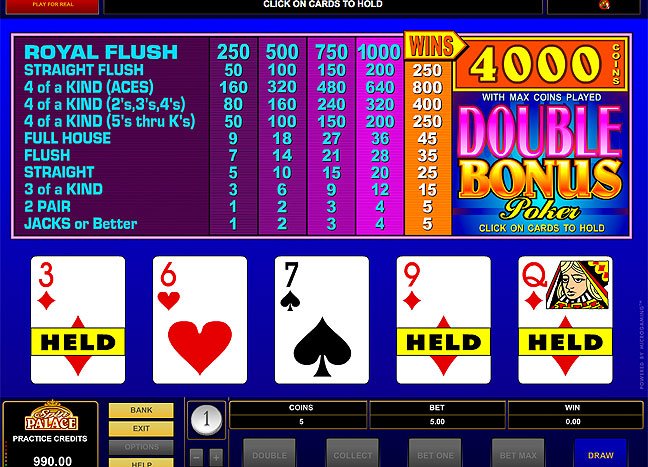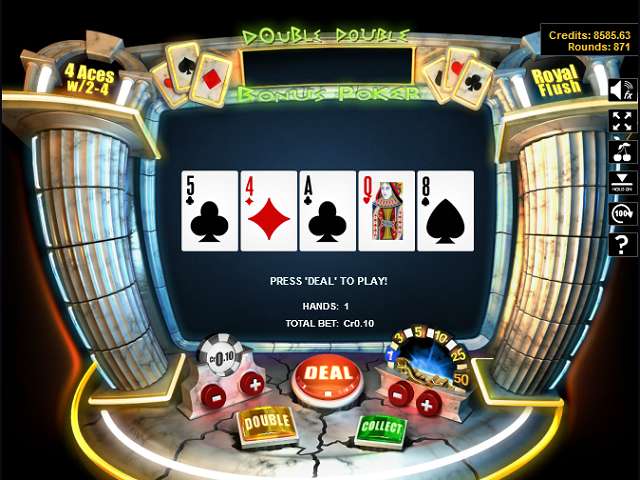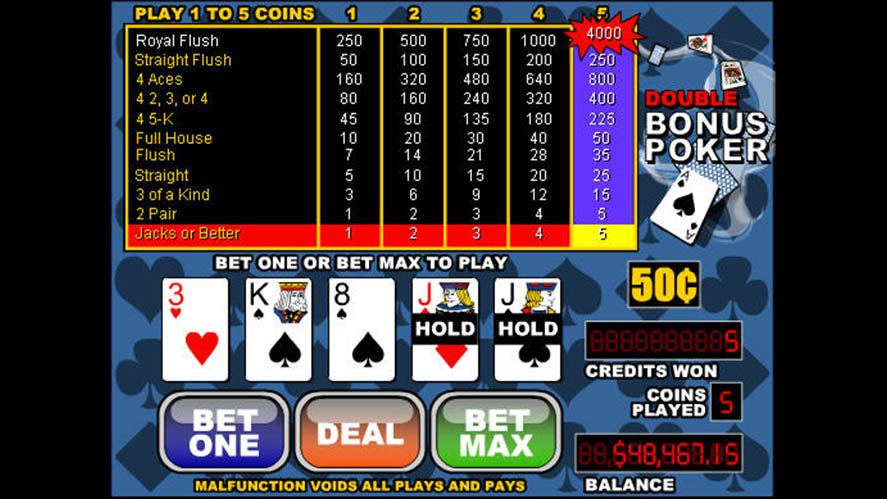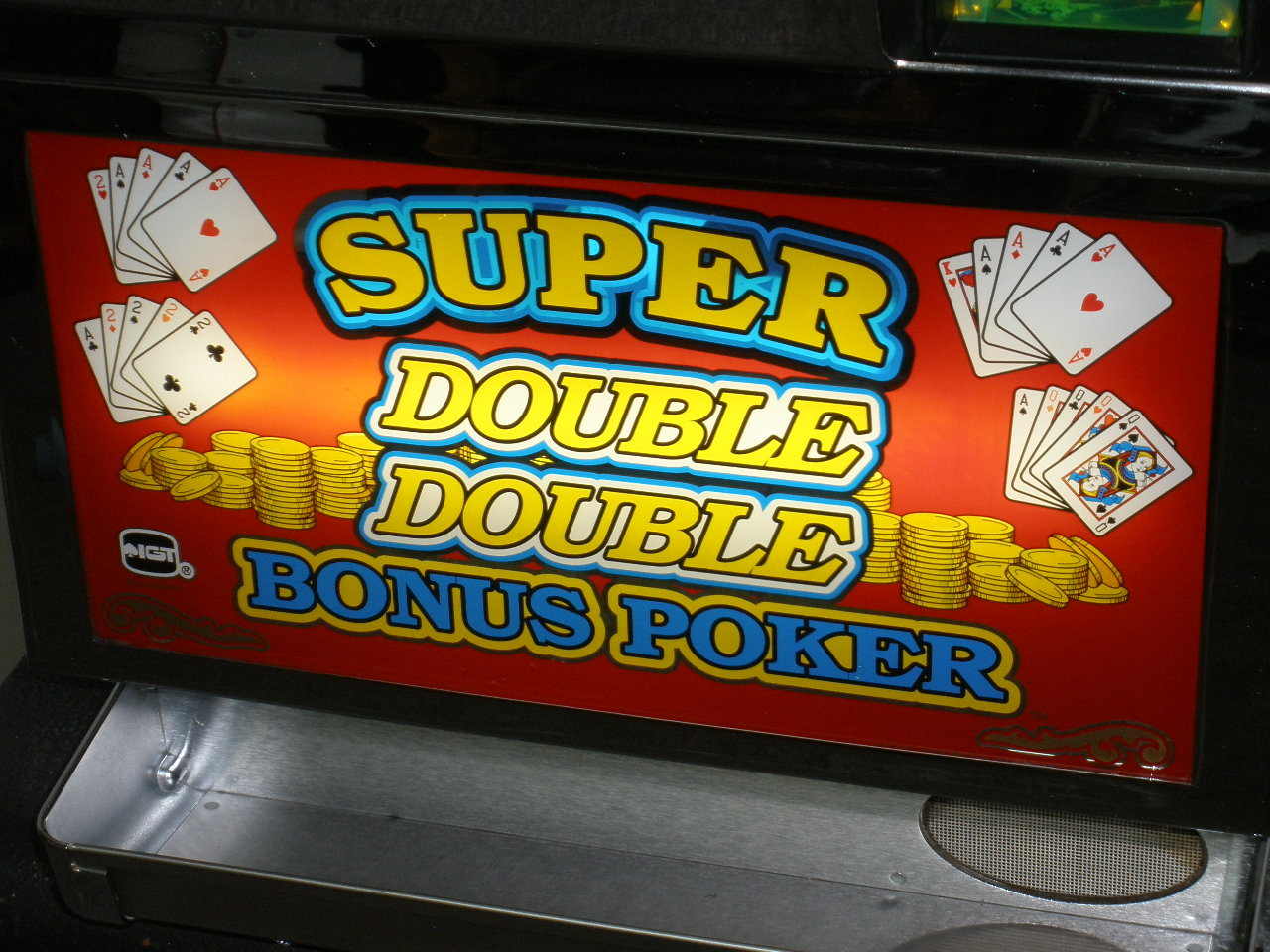Double Bonus Poker
| The best way to learn our Double Bonus strategy is to use it as you play. We recommend practicing Double Bonus at Bovada Casino. Bovada offers Double Bonus for both practice and real money play. One of my favorite parts about Bovada Casino is that you don't have to download the casino to play - you can practice right in your web browser. Practice Double Bonus at Bovada Casino now! |
On this page we're going to discuss what I believe is the best possible strategy for playing Double Bonus video poker. By using this strategy you will be able to achieve a return of over 100%, which means that you can actually beat the house edge. Our strategy was created for full pay Double Bonus which uses the pay table listed below:
| Hand: | Payout: |
| Royal Flush | 800 |
| Straight Flush | 50 |
| Four Aces | 160 |
| Four Two's-Four's | 80 |
| Four Five's-King's | 50 |
| Full House | 10 |
| Flush | 7 |
| Straight | 5 |
| Three of a Kind | 3 |
| Two Pair | 1 |
| Jacks or Better | 1 |
- The new bonus hands that were introduced on ‘ Double Double Bonus Poker ‘ are also here are for a four of a kind made up of Aces, with a 2,3 or 4 kicker. That pays 2000 coins for max bet—a hefty $500 on a.25 cent machine. The other bonus hand is a four of a kind comprised of 2,3.
- More Games Select from 19 different video poker variations with the button, including Jacks or Better, Bonus, Double Double, Triple Double, Full Pay Deuces, 16/10 (Not So Ugly) Deuces, Loose Deuces, three kinds of Joker Poker, and more. Keyboard You can use the mouse to click on cards to hold, or you may find it easier to use the keyboard.
- A variation of Double Bonus Poker with payouts of 50/9/7 for the above-listed hands has a return percentage of around 99.16%. Strategy Tips for Optimal Double Bonus Poker Play. If you want to make the most of your Double Bonus Poker session, you are recommended to adopt optimal strategy that takes the game’s oddities into account.
Please note that to achieve the 100%+ payout percentage, you need to be betting five coins per hand. By betting five coins you'll receive a bonus for all royal flushes, which drastically improves the payout percentage in the long run. Learn about other Double Bonus pay tables.
Double Double Bonus Poker, the kicker is actually important to be aware of, unlike in other video poker variants. If you refer to the payout table above, you can see that four aces with a 2, 3, or 4 as a kicker will pay you 400 coins. Subsequently, four 2s, 3s, or 4s with an A, 2, 3, or 4 kicker pays out 160 coins. Double Double Bonus Poker (DDB) is the most popular video poker game in the country. That’s because it’s possible to hit several big payouts besides the royal flush, and this draws players to the game. Unfortunately, there are also some pitfalls to playing DDB, which most players are not aware of.
Beginner Double Bonus Strategy
If you're a new Double Bonus player, you're probably better off to stick with the beginner chart for now. It's much more simple and will help you make decisions quickly as you learn the game. This chart isn't as accurate as the full chart below, so if you're looking for the best possible strategy use the full expert chart we have below.
Here is how you should use the chart below:
- Find your trouble hand on the chart.
- Follow the chart's recommendation.
Example: Imagine you have Kc-Qc-Jc-Tc-4c. In this case you have a pat flush, but you also have an open ended straight flush draw including a draw to a royal flush. By looking at the chart below, you'll see that a royal flush draw is better than a pat flush, so make sure to discard the 4c and go for the straight flush/royal.
- Royal Flush Draw vs. Pat Straight Flush » Keep the Straight Flush
- Royal Flush Draw vs. Pat Flush » Keep the Royal Flush Draw
- Three of a Kind Aces vs. Full House » Keep the Three Aces
- Pat Straight vs. Four to a Straight Flush » Keep the Straight
- Two Pair vs. a Pair of Aces » Keep the Two Pair
- Four to a Flush vs. Four to a Straight » Keep the Four to a Flush
- Pair (Jacks through Aces) vs. Open Four to Straight » Keep the Pair
- Open Four to Straight vs. Pair (Twos through Tens) » Keep the Straight Draw
- Ace/King/Queen/Jack vs. Discard Everything » Keep the Ace/King/Queen/Jack
Expert Double Bonus Strategy

Here is how you should use the chart below:
- Start at the top of the chart and work down.
- When you see a hand that matches up with yours, follow that strategy.
Example: Imagine you have Qs-Js-Ts-3s-Jh. In this case, you'd match up with a few rows on the table below. Your hand would qualify for a high pair of Jacks, a Q-J-T suited with one penalty (the other Jack is a penalty card), and four to a flush. However, on the table you'll notice that Q-J-T suited with one penalty is higher than a four flush or a pair, so you should keep the Q-J-T suited and ditch the four flush and pair.
Double Bonus Full Strategy Chart
Here are the ranks for every possible Double Bonus hand. Remember, find the highest match on the list for your hand and hold those cards. The middle column shows the expected return for the specific hand. In the example column, h = Hearts, s = Spades, c = Clubs, d = Diamonds, T = Ten, s = Suited.
| Hand | Expected Return | Example |
| Pat Royal Flush | 800.0000 | Th-Jh-Qh-Kh-Ah |
| Four of a Kind Aces | 160.0000 | Ac-Ah-Ad-As-3c |
| Four of a Kind Twos, Threes, Fours | 80.0000 | 2h-2s-2c-2d-7c |
| Four of a Kind Fives - Kings | 50.0000 | 7c-7d-7h-7s-Jc |
| Pat Straight Flush | 50.0000 | 6h-7h-8h-9h-Th |
| Royal Flush Draw | 18.6383 | Th-Jh-Qh-Kh-4h |
| Three of a Kind Aces | 10.1147 | Ac-Ad-Ah-Js-8c |
| Pat Full House | 10.0000 | Ac-Ad-As-Js-Jc |
| Pat Flush | 7.0000 | Ac-Jc-6c-5c-4c |
| Three of a Kind Twos, Threes, Fours | 6.7105 | 3c-3h-3d-8s-9s |
| Three of a Kind Fives through Kings | 5.4339 | 8c-8s-8d-9h-3d |
| Pat Straight | 5.0000 | 4c-5s-6h-7h-8h |
| Open Straight Flush Draw | 3.7383 | 4c-5c-6c-7c-Th |
| Inside Straight Flush Draw | 2.4894 | Qs-Js-9s-8s-4c |
| Two Pair | 1.7660 | 3c-3s-4d-4h-Ac |
| Pair of Aces | 1.7635 | Ac-Ad-Js-8c-5h |
| Q-J-T suited (w/ no penalty*) | 1.5846 | Qh-Jh-Th-4d-3d |
| K-Q-J suited (w/ no penalty*) | 1.5754 | Kh-Qh-Jh-4c-3c |
| Q-J-T suited (w/ one Straight penalty*) | 1.5634 | Qh-Jh-Th-Kc-2c |
| Q-J-T suited (w/ one High Pair penalty*) | 1.5430 | Qh-Jh-Th-Jc-4s |
| K-Q-J suited (w/ one Straight penalty*) | 1.5384 | Kh-Qh-Jh-Tc-4c |
| K-Q-J suited (w/ one High Pair penalty*) | 1.5365 | Kh-Qh-Jh-Js-3s |
| Four to a Flush, 3 High Cards (w/ no penalty*) | 1.5319 | Ac-Jc-Tc-3h-2h |
| Q-J-T suited (w/ one Flush penalty*) | 1.5264 | Qh-Jh-Th-4h-3c |
| Four to a Flush, 3 High Cards (w/ 1 HP penalty*) | 1.5106 | Ac-Jc-Tc-3c-Th |
| Q-J-T suited (w/ any two penalties*) | 1.4894 | Qs-Js-Ts-Kh-Jc |
| K-Q-J suited (w/ any two penalties*) | 1.4783 | Kh-Qh-Jh-Jc-Ts |
| K-Q-T suited, K-J-T suited (w/ no penalty*) | 1.4755 | Kh-Qh-Th-4c-3c |
| Four to a Flush, 2 High Cards (w/ no penalty*) | 1.4681 | Kh-Jh-7h-5h-2c |
| A-K-Qs, A-K-Js, A-Q-Js (w/ no penalty*) | 1.4662 | Ac-Kc-Jc-2h-3h |
| Pair of Jacks, Queens, Kings | 1.4582 | Jc-Js-2h-4c-8s |
| K-Q-Ts, K-J-Ts (w/ one Straight penalty*) | 1.4542 | Kh-Qh-Th-Jc-2c |
| A-K-Qs, A-K-Js, A-Q-Js (w/ one Straight penalty*) | 1.4450 | Ac-Kc-Qc-Jh-2h |
| Four to a Flush, One High Card | 1.4042 | Ac-8c-7c-3c-6h |
| K-Q-T suited, K-J-T suited (w/ two penalties*) | 1.3959 | Kh-Qh-Th-Jc-Qc |
| A-K-Ts, A-Q-Ts, A-J-Ts(w/ no penalty*) | 1.3663 | Ac-Kc-Tc-2h-3h |
| Four to a flush, No High Cards | 1.3404 | 9c-7c-4c-2c-8s |
| A-K-Ts, A-Q-Ts, A-J-Ts (w/ one St. penalty*) | 1.3395 | Ac-Kc-Tc-Jh-2s |
| Open Four to a Straight | 0.9149 | Jc-Ts-9h-8c-2h |
| Pair of Twos, Threes, Fours | 0.8266 | 2c-2h-7s-8c-Jh |
| J-T-9 suited | 0.7826 | Jc-Tc-9c-4h-3h |
| Q-J-9 suited | 0.7761 | Qc-Jc-9c-4h-3h |
| Pair of Fives through Tens | 0.7434 | 5c-5h-Js-8d-2h |
| Three to a Straight Flush, Open, No High Cards | 0.6855 | 4c-5c-6c-Th-9h |
| A-K-Q-J | 0.6789 | Ac-Ks-Jh-Ts-3s |
| Q-J-8 suited | 0.6644 | Qc-Jc-8c-6h-4h |
| Q-T-9 suited, J-T-8 suited, J-9-8 suited | 0.6577 | Jc-9c-8c-4h-3h |
| K-Q-9 suited, K-J-9 suited | 0.6512 | Kc-Qc-9c-4h-2h |
| Four to a Straight, Inside, Three High Cards | 0.6170 | Qc-Js-Ts-8d-2h |
| Q-J suited (w/ no or one penalty*) | 0.5871 | Qc-Jc-4h-8s-2h |
| K-Q suited, K-J suited (w/ no penalty*) | 0.5845 | Kc-Qc-8s-4h-2s |
| Q-J suited (w/ two penalties*) | 0.5772 | Qs-Js-Th-6c-4s |
| 3 to a St. Flush, 1 Gap, 0 Hi Cards (no penalty*) | 0.5726 | 4h-5h-7h-9c-Tc |
| A-Ks, A-Qs, A-Js (w/ no penalty*) | 0.5692 | Ac-Kc-6s-9d-2h |
| 3 to a St. Flush, 2 Gaps, 1 Hi Card (no penalty*) | 0.5671 | 4h-6h-8h-Jc-2s |
| K-Qs, K-Js (w/ one Flush penalty*) | 0.5650 | Ks-Qs-8s-6h-2h |
| Q-J suited (w/ three penalties*) | 0.5650 | Qs-Js-Tc-8c-2s |
| K-Qs, K-Js (w/ one or two Straight penalties*) | 0.5642 | Ks-Qs-Jc-9c-2h |
| Three to a Flush, Two High Cards | 0.5606 | As-Js-3s-5c-9c |
| A-Ks, A-Qs, A-Js (w/ one Straight penalty*) | 0.5596 | As-Ks-Tc-2h-6h |
| K-Qs, K-Js (w/ 1 St. penalty + 1 Flush penalty*) | 0.5582 | Ks-Qs-Tc-6s-4d |
| 3 to a St. Flush, 1 Gap, 0 Hi Cards (St. penalty*) | 0.5578 | 5h-6h-8h-9c-2s |
| Four to a Straight, Inside, Two High Cards | 0.5532 | Qs-Jd-9c-8h-2s |
| K-Qs, K-Js (w/ three penalties*) | 0.5515 | Ks-Qs-Th-Td-2s |
| 3 to a St. Flush, 2 Gaps, 1 High Card (St. penalty*) | 0.5486 | 8h-Th-Qh-9c-2s |
| K-Q-J | 0.5199 | Kh-Qs-Jc-4c-2h |
| J-T suited (w/ no penalty*) | 0.5011 | Jc-Tc-6s-4d-2d |
| Q-J-T | 0.4940 | Qc-Jd-Th-7s-2d |
| Four to a Straight, Inside, One High Card | 0.4894 | Jc-Ts-9d-7h-2s |
| J-T suited (w/ one Flush penalty*) | 0.4817 | Js-Ts-6s-4c-2h |
| J-T suited (w/ one or two Straight penalties*) | 0.4747 | Js-Ts-8c-7c-2h |
| Q-J | 0.4745 | Qc-Jh-7d-5c-2h |
| 9-7-5 suited, 9-6-5 suited | 0.4699 | 9c-7c-5c-2h-3h |
| Q-T suited (w/ no penalty*) | 0.4683 | Qc-Tc-7s-5h-2s |
| 3 to a St. Flush, 2 Gaps, 0 Hi Cards (no penalty*) | 0.4672 | 5h-7h-9h-2d-3d |
| J-Ts (w/ 1 Straight penalty + 1 Flush penalty*) | 0.4652 | Js-Ts-8c-2s-5h |
| K-Q, K-J (w/ no penalty*) | 0.4623 | Ks-Qc-8h-5h-3d |
| Three to a Flush, One High Card | 0.4598 | Js-8s-4s-3c-2c |
| J-T suited (w/ three penalties*) | 0.4588 | Js-Ts-7c-Ad-2s |
| K-Q, K-J (w/ one Straight penalty*) | 0.4574 | Kc-Qs-9d-5h-2c |
| Ace (w/ no flush penalty*) | 0.4552 | Ad-Tc-7s-4s-2h |
| Ace (w/ one flush penalty + no 2, 3, 4 or 5) | 0.4499 | Ah-9h-Jc-7s-6d |
| A-K, A-Q, A-J | 0.4493 | Ac-Kh-9d-7c-4s |
| K-T suited | 0.4487 | Kc-Tc-7s-5d-2d |
| Ace (w/ one flush penalty*) | 0.4487 | Ah-Th-7s-5c-2d |
| Jack (w/ no flush penalty*) | 0.4451 | Jd-9s-7c-4h-2h |
| 3 to a St. Flush, 2 Gaps, 0 Hi Cards (St. penalty*) | 0.4431 | 4h-6h-8h-7c-Td |
| Queen | 0.4341 | Qc-9d-7d-4s-2s |
| King | 0.4310 | Kh-Ts-8d-5d-2c |
| Jack (w/ one Flush penalty*) | 0.4306 | Jd-8d-5c-3s-2s |
| Four to a Straight, Inside, no High Cards | 0.4255 | 5d-6c-7s-9h-2d |
| Three to a Flush, no High Cards | 0.3608 | Th-7h-5h-3s-2s |
| Everything Else » Draw Five New Cards | 0.3231 | 10s-8c-6d-4s-2h |
*Penalty cards are any cards which you plan to discard that hurt your chances of completing a draw. For example, if you have 7c-9c-Jc-8s-5h and plan to keep the 7c-9c-Jc, the 8s that you're discarding actually hurts you because there is one less card in the deck that completes your straight. However, it still makes sense to discard the 8s because you have better expected return going for the straight flush than to draw to the inside straight.
Straight (St.) penalty cards mean cards that interfere w/ a hand's possibility of making a straight. Flush penalty cards mean cards that interfere w/ a hand's possibility of making a flush. High Pair (HP) penalty cards mean cards that interfere w/ a hand's possibility of making a high pair (a pair Jacks or better).

Double Bonus Poker Game
How to score big payouts while avoiding the pitfalls
By Henry Tamburin
The larger payoffs come at a price; namely, the payoff for two pair is only even money (or 1 to 1). By transferring some of the game’s payouts from the more frequent two pair to the less frequent four-of-a-kind, it becomes a much more volatile game.
Double Double Bonus Poker (DDB) is the most popular video poker game in the country. That’s because it’s possible to hit several big payouts besides the royal flush, and this draws players to the game. Unfortunately, there are also some pitfalls to playing DDB, which most players are not aware of.
Table 1 summarizes the different pay schedules for DDB that you are likely to encounter. The first thing that should jump out at you is the amount of the payoffs for four-of-a-kind hands. They are rather large payoffs, especially if the fifth card in the hand (the “kicker”) is a specific card.
For example, the payoff for four Aces is 160 times your bet but if the kicker is a 2, 3, or 4, the payoff jumps to 400 coins. (That’s a 2000-coin payoff, or one-half the payoff for a royal flush, betting the maximum of five coins.) Likewise, the payoffs for four 2s, 3s, and 4s increases from 80 to 160 coins times your bet with an Ace, 2, 3, or 4 kicker. These mini-jackpots are the magnet that attracts players to this game.
What most players don’t understand is the larger payoffs come at a price; namely, the payoff for two pair is only even money (or 1 to 1). By transferring some of the game’s payouts from the more frequent two pair to the less frequent four-of-a-kind, it becomes a much more volatile game (more about this shortly).

Tabl1 also summarizes the ER for the different DDB pay schedules (bottom of each column). The best DDB game pays 10 coins for a full house and 6 coins for a flush per coin played (see Table 1). The Expected Return (ER) for 10/6 DDB is 100.07%, meaning the player would have a tiny advantage over the house if he played every hand perfectly.
There are many casinos in the Las Vegas area that offer 10/6 DDB. (Just go to either www.vpfree2.com or the video poker page on www.lasvegasadvisor.com to obtain a list of casinos that offer 10/6 DDB at different denominations.) Unfortunately, 10/6 DDB is not readily available in other areas of the country. (Partly the reason for this in that in some gaming jurisdictions, casinos can’t offer a game where the ER is over 100%). Nevertheless, it behooves you to find a casino that has at least the 9/6 DDB pay schedule, which has a 98.98% ER. (I wouldn’t recommend playing the 9/5 or 8/5 DDB games because the ERs are woeful. Again, check www.vpfree2.com for a list of casinos outside Las Vegas that offer 9/6 DDB.)
The high volatility of DDB results in most players going broke rather quickly if they are not lucky enough to hit one of the high payoff hands. In other words, most players play DDB undercapitalized. For example, supposed you were to play 9/6 Double Double Bonus instead of the much less volatile 8/5 Bonus Poker (BP). Both games have roughly a 99% expected return (ER) but the variance for 9/6 DDB is much higher (41.99) compared to 8/5 BP (20.90) Let’s assume you have a $200 bankroll and you want to play for two hours (1000 hands). By using the bankroll function in the Video Poker for Winners software program, you can determine what your chances are of going broke for each game. The results are:
Playing the low-volatile 8/5 Bonus Poker, you will lose your $200 stake only 2.55% of the time on average (that’s roughly 1 out of every 40 sessions).

Playing the more volatile 9/6 Double Double Bonus Poker, you will lose your $200 stake 28.66% of the time (that’s roughly 11 out of every 40 sessions you’ll tap out).
This means you are 11-times more likely to tap out with your $200 bankroll if you play 9/6 DDB instead of 8/5 BP. The point is this: Video poker games that are highly volatile (such as Double Double Bonus) require more bankroll to prevent going broke. (Also, your “emotional” bankroll will be tested in games that are highly volatile because you can experience some long “dry spells”.) Let me repeat this so it sinks in: DDB is very volatile.
Assuming you have the bankroll and the stomach to play DDB, you should master the playing strategy before you risk any money. The playing strategy for DDB is tricky because of the importance of the ace (see my Tip of the Month). You’ll find a playing strategy for DDB on the video poker page at www.wizardofodds.com. You should also consider practicing the strategy at home with video poker training software until your playing accuracy is at least 99% before risking money in a casino. (I recommend Video Poker For Winners or Optimum Video Poker training software, both available on my web site.) I also recommend that you purchase the DDB strategy card by Dancer and Daily and take it with you when you play so that if you are not sure how to play a hand, you can refer to the strategy card.
TABLE 1
Double Double Bonus Poker Pay Schedule
Payout Per Coin Played
10/6 | 9/6 | 9/5 | 8/5 | |
| Royal Flush | 800* | 800* | 800* | 800* |
| Straight Flush | 50 | 50 | 50 | 50 |
| 4 Aces with 2, 3, 4 kicker | 400 | 400 | 400 | 400 |
| 4 Aces | 160 | 160 | 160 | 160 |
| 4 2s, 3s, 4s with A, 2, 3, 4 kicker | 160 | 160 | 160 | 160 |
| 4 2s, 3s, 4s, | 80 | 80 | 80 | 80 |
| 4 5s-Ks | 50 | 50 | 50 | 50 |
| Full House | 10 | 9 | 9 | 8 |
| Flush | 6 | 6 | 5 | 5 |
| Straight | 4 | 4 | 4 | 4 |
| 3-of-a-Kind | 3 | 3 | 3 | 3 |
| Two Pair | 1 | 1 | 1 | 1 |
| Jacks-or-Better | 1 | 1 | 1 | 1 |
| Expected Return (ER) | 100.07% | 98.98% | 97.87% | 96.79% |
* 4000 coins for a five-coin royal flush
Tamburin Tip of the Month
You are playing Double Double Bonus and are dealt the following two hands. How would you play them?
You should break up the full house in the first hand, hold only the three aces, and draw two more cards. In the second hand, you break up the two pair, hold the pair of aces, and draw three cards.
————————————————————————————————————-
Double Bonus Video Poker Trainer
Henry Tamburin is a blackjack and video poker expert. He is the host of the smartgaming.com website and the editor of the Blackjack Insider newsletter (for a free three-month subscription, visit www.bjinsider.com/free). For a free copy of his Casino Gambling Catalog, which contains books, strategy cards, and software for video poker players, call toll free 1-888-353-3234, or visit the web store at smartgaming.com.